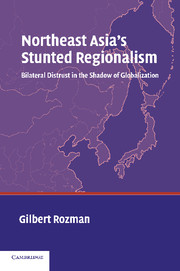Book contents
- Frontmatter
- Contents
- Acknowledgments
- Map
- Northeast Asia's Stunted Regionalism
- 1 Introduction: The Challenge of the Northeast Asia Region
- 2 Exiting the 1980s: Cold War Logic and National Aspirations
- 3 1991–1993: Border Fever and Cross-Border Duplicity
- 4 1994–1996: Civilizational Bridges and Historical Distrust
- 5 1997–1998: Strategic Partnerships and National Rivalries
- 6 1999–2000: Sunshine Policy and Security Dilemmas
- 7 2001–2003: Unilateralism and Irrepressible Regionalism
- 8 Conclusion: Lessons for Constructing Regionalism in Northeast Asia
- Index
8 - Conclusion: Lessons for Constructing Regionalism in Northeast Asia
Lessons for Constructing Regionalism
Published online by Cambridge University Press: 18 December 2009
- Frontmatter
- Contents
- Acknowledgments
- Map
- Northeast Asia's Stunted Regionalism
- 1 Introduction: The Challenge of the Northeast Asia Region
- 2 Exiting the 1980s: Cold War Logic and National Aspirations
- 3 1991–1993: Border Fever and Cross-Border Duplicity
- 4 1994–1996: Civilizational Bridges and Historical Distrust
- 5 1997–1998: Strategic Partnerships and National Rivalries
- 6 1999–2000: Sunshine Policy and Security Dilemmas
- 7 2001–2003: Unilateralism and Irrepressible Regionalism
- 8 Conclusion: Lessons for Constructing Regionalism in Northeast Asia
- Index
Summary
Combining China, Japan, and South Korea at the core with eventual inclusion of other areas, from the eastern edge of Russia to North Korea, regionalism is taking shape in NEA after a rough decade of false starts and uncoordinated, if repeatedly refreshed, hopes. The process has been arduous because of the historical legacy in the region, the difficulty in building on truncated forces of globalization and localism, and domestic uncertainties in defining priorities at a time of resurgent nationalism. Examining the record of failure to realize regional goals in the transitional decade after the cold war, we can draw useful lessons on how regionalism in NEA can be fully realized. From the chronology of past efforts we discern that a drive for regionalism is likely to come from: 1) the extraordinary pace of intraregional trade and investment, driven of late by the dynamism of coastal China as well as the spillover from increased openness with entry into the WTO; 2) a backlash from assertive unilateralism by the United States, pressing down on nations anxious to gain foreign-policy leverage; 3) a common interest in stabilizing systemic change in North Korea and Sino-Japanese volatility; and 4) a shared competitive streak that recognizes the limited influence of each of their separate economies, along with the compelling benefits to be achieved from the larger scale and international recognition of a regional voice on economics first of all.
Why does regionalism matter to the nations of NEA?
- Type
- Chapter
- Information
- Northeast Asia's Stunted RegionalismBilateral Distrust in the Shadow of Globalization, pp. 351 - 380Publisher: Cambridge University PressPrint publication year: 2004



